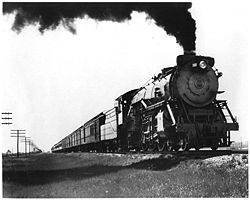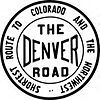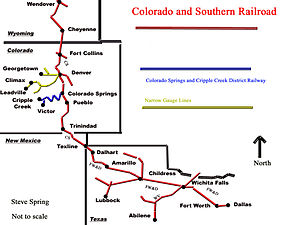- Fort Worth and Denver Railway
-
Fort Worth and Denver Railway 
Fort Worth and Denver's "Colorado Special" rolls through the Texas Panhandle (1929)Reporting mark FWD Locale Texas Dates of operation 1881–1982 Successor Burlington Northern, BNSF Track gauge 4 ft 8 1⁄2 in (1,435 mm) (standard gauge) Headquarters Fort Worth, Texas The Fort Worth and Denver Railway (reporting mark FWD), nicknamed "the Denver Road," was a class I American railroad company that operated in the northern part of Texas from 1881 to 1982, and had a profound influence on the early settlement and economic development of the region.
The Fort Worth and Denver City Railway Company (FW&DC) was chartered by the Texas legislature on May 26, 1873. The company would later change its name to the Fort Worth and Denver Railway Company (FW&D) on August 7, 1951.[1]
The main line of the railroad ran from Fort Worth through Wichita Falls, Childress, Amarillo, and Dalhart, to Texline, where it connected with the rails of parent company Colorado and Southern Railway, which became a subsidiary of the Burlington Route.
Contents
Construction
The Panic of 1873 delayed the start of construction until 1881, when Grenville M. Dodge became interested in the project. Dodge, as chief engineer for the Union Pacific Railroad, had played a large part in the construction of the First Transcontinental Railroad. Dodge organized the Texas and Colorado Railway Improvement Company in 1881 to build and equip the FW&DC in return for $20,000 in stock and $20,000 in bonds for each mile of track laid. In the same year, The FW&DC and the Denver and New Orleans Railroad Company, organized in Colorado, agreed to connect their systems at the Texas-New Mexico border. The FW&DC received no state subsidy other than the right-of-way easements to cross state-owned lands totaling 2,162 acres (8.75 km2).[1]
Beginning construction at Hodge Junction, just north of Fort Worth, on November 27, 1881, by September 1882 Dodge had completed 110 miles (180 km) of track to Wichita Falls, Texas. By 1885, the line reached Harrold[2]; by 1886, Chillicothe; by 1887, Clarendon and Amarillo;[3] and by 1888, Texline on the New Mexico border. Continuing into the New Mexico Territory, the FW&DC finally linked with the D&NO where the railheads met at Union Park, near present-day Folsom, New Mexico, 528 miles (850 km) from Fort Worth, on March 14, 1888.[1]
Railroad service between Fort Worth and Denver began on April 1, 1888. In 1895, Dodge became president of the company, one of several railroads he held a financial interest in.[4]
Expansion
In 1899, The FW&DC was acquired by the Colorado and Southern Railway, successor to the D&NO. The C&S itself was bought by the Chicago, Burlington and Quincy Railroad in 1908; however, the three companies continued to operate as separate legal entities. In part, this separation was due to Texas law, which required all railroads operating in the state to have their headquarters in Texas This had the effect of requiring all operating railroads in Texas to be wholly owned, but independent companies of the regional or national roads.[5]
The FW&DC was the first rail line to penetrate the northwest part of Texas, which contributed greatly to the growth of Texas cities such as Wichita Falls, Childress, and Amarillo. In addition, the railroad actively promoted settlement of the rural areas it served, providing free seeds, trees, and tree seedlings to farmers and ranchers to promote cotton and wheat growing as well as erosion prevention.[1]
In the first four decades of the twentieth century, the FW&DC built or acquired a number of feeder lines in its territory, so that by 1940, the Burlington-owned system operated 1,031 miles (1,659 km) of main track in Texas in addition to the Burlington-Rock Island Railroad.[6]
The Fort Worth and Denver City leased the Fort Worth and Denver South Plains (completed in 1928, 206 miles (332 km) from Estelline to Plainview and Lubbock; the Fort Worth and Denver Northern (completed in 1932, 110 miles (180 km) from Childress to Pampa); and the Fort Worth and Denver Terminal (providing access to railyards and terminals in Fort Worth).[1]
Several feeder lines operated by the Wichita Valley Railway Company (another subsidiary of the Colorado and Southern) connected with the FW&DC at Wichita Falls, including lines to Abilene, Texas and Waurika, Oklahoma. In 1952, the Wichita Valley and its subsidiaries were merged into the Fort Worth and Denver Railway.[1]
In 1925, the FW&DC had extended service from Fort Worth to Dallas by acquiring trackage rights over the Rock Island Railroad between those cities. At Dallas, FW&DC trains connected with the Burlington-Rock Island Railroad for through service to Houston.
Peak and decline
The premier passenger train of the FW&DC was the streamlined Texas Zephyr, which operated between Dallas and Denver from 1940 to 1967. At the railroad's peak in 1944, during the World War II economic boom, the Texas Railroad Commission reported that the FW&DC earned $12,132,515 in freight revenue, $5,839,399 in passenger revenue, and $1,488,095 in other revenue. However, by 1972, in the face of competition from interstate highway traffic and airlines, the Fort Worth and Denver owned twenty locomotives and 1,520 freight cars, but operated at a loss of $1,743,551.[6]
Successor companies
In 1970, the Chicago, Burlington and Quincy Railroad, the Great Northern Railway, and the Northern Pacific Railroad merged themselves into a single railroad, the Burlington Northern Railroad; however, their subsidiaries in Colorado and Texas continued to have a separate legal existence until the Burlington Northern acquired the Fort Worth and Denver Railway by virtue of the merger between BN and the Colorado and Southern Railroad on December 31, 1981. The Fort Worth and Denver Railway's corporate existence came to an end when it was formally merged into Burlington Northern Railroad on December 31, 1982.[6]
The FW&D's former main line through the Texas Panhandle and North Texas is now a heavily used route of BN's successor, the BNSF Railway, primarily for coal and intermodal trains between Fort Worth and the western United States.[7] Additionally, the Union Pacific Railroad has trackage rights on this line from Fort Worth to Dalhart.[8] However, no passenger trains have operated in scheduled revenue service on this route since the FW&D ended all passenger service in 1967, before the creation of Amtrak in 1971.
Rails to trails
In 1989, BN abandoned the former Fort Worth and Denver South Plains trackage between Estelline and Lubbock. In 1993, the Texas Parks and Wildlife Department acquired 64 miles (103 km) of the abandoned right-of-way between Estelline and the town of South Plains to create the Caprock Canyons State Park and Trailway's hike and bike trail.[1]
The Saints' Roost Museum in Clarendon houses a restored Fort Worth and Denver Railway depot.[9]
References
- ^ a b c d e f g Handbook of Texas Online - FORT WORTH AND DENVER RAILWAY
- ^ "Fort Worth And Denver.; To Be Extended To Some Point In New-Mexico". The New York Times. December 11, 1885. http://query.nytimes.com/mem/archive-free/pdf?_r=1&res=9D07E6DC123FE533A25752C1A9649D94649FD7CF&oref=slogin.
- ^ Texas Historical Marker - Fort Worth and Denver City Railway, First Railroad through the Texas Panhandle
- ^ Fort Worth and Denver Railway Company: An Inventory of Photographs, undated, at the Southwest Collection/Special Collections Library
- ^ Handbook of Texas Online - RAILROADS
- ^ a b c Burlington Route
- ^ http://www.atsfrr.com/resources/MillerJay/railfan_guide.pdf
- ^ wfrrm01
- ^ The Saints' Roost Museum
External links
- Map of the Burlington Route railroad system from the mid-twentieth century, including the Fort Worth and Denver lines
- Original research, 1912-1983, by Eugene Pellette in the Southwest Collection/Special Collections Library at Texas Tech University
Bibliography
- Fort Worth and Denver Railway Company from the Handbook of Texas Online. URL accessed on April 3, 2006.
- Goen, Steve Allen. Fort Worth & Denver: Color Pictorial. Four Ways West Publications, 1996.
- Overton, Richard C. (1965). Burlington Route: A History of the Burlington Lines. Knopf.
- Overton, Richard C. Gulf to Rockies: The Heritage of the Fort Worth and Denver - Colorado and Southern Railways, 1861-1898. Austin: University of Texas Press, 1953.
- Wagner, F. Hol. "The Colorado Road": history, motive power, & equipment of the Colorado and Southern and Fort Worth and Denver Railways. Intermountain Chapter, National Railway Historical Society, 1970.
Class I railroads of North America Current Former
(1956–present)AA · ACL · AC&Y · AGS · A&SAB · AT&N · AT&SF · AUT · A&WP · B&AR · B&LE · B&M · BN · B&O · CAR&NW · CB&Q · C&EI · CG · CGW · C&IM · CNJ · CNO&TP · C&NW · C&O · CPME · CR · CRI&P · CRR · C&S · CSPM&O · CV · C&W · C&WC · D&H · DL&W · DM&IR · D&RGW · DSS&A · DT&I · D&TSL · DW&P · EJ&E · EL · ERIE · FEC · FW&D · GA · GB&W · G&F · GM&O · GN · GS&F · GTW · IC · ICG · ITC · KO&G · L&A · L&HR · LI · L&M · L&N · L&NE · LS&I · LV · MEC · MGA · MI · MILW · MIS · MKT · MN&S · MON · MP · M&STL · NC&STL · NH · NKP · NO&NE · NP · NS · N&W · NWP · NYC · NYCN · NYO&W · NYS&W · PC · P&LE · P&N · PRR · PRSL · P&WV · RDG · RF&P · RUT · QA&P · S&A · SAL · SBD · SCL · SD&AE · SI · SIRT · SLSF · SLSFTX · SN · SOU · SP · SP&S · SSW · TC · TFM · TM · T&NO · T&P · TP&W · VGN · WA · WAB · WC · WM · WP(pre–1956) A · AB&A · AB&C · AC · A&D · AE · A&NM · A&STL · A&V · BA&P · BC&A · B&G · BRI · BR&P · B&S · BSL&W · C&A · CA&C · C&C · CC&CS · CCC&STL · CD&C · C&E · C&G · CH&D · C&I · CINN · CI&S · CI&W · CL&N · CM · CM&PS · CNE · CNNE · CNOR · C&OIN · CP&STL · CPVT · CRI&G · CR&NW · CRP · CS · CTH&SE · CV&M · CVRR · DGH&M · D&IR · D&M · DM&N · DNW&P · D&SL · EI&TH · EP&SW · E&TH · F&CC · FJ&G · FS&W · FW&RG · GC · GC&SF · GH&SA · GM&N · GR&I · G&SI · HE&WT · H&TC · HV · ICRY · IGN · ISRR · KCM&O · KCM&OTX · K&M · LA&SL · LA&T · LE&W · LH&STL · LR&N · LR&NTX · LS&MS · LW · MTR · M&A · MC · MD&V · M&I · MKTTX · MLR · ML&T · M&NA · M&O · MO&G · MSC · MSP&SSM · MV · NAL · NCRY · NJ&NY · NN · NOGN · NOM&C · NOT&M · NYP&N · OCAA · OE · OR&L · OSL · OWRN · PB&W · PCC&STL · PCO · PE · P&E · PERK · PM · P&NT · PRDG · P&S · P&SF · PS&N · QO&KC · SA&AP · SAU&G · SB&NY · SD&A · SFP&P · S&IE · SIND · SJ&GI · SKTX · SLB&M · SLIM&S · SOUMS · SSWTX · SUN · T&BV · T&FS · T&N · T&OC · TSTL&W · U&D · UTAH · VAND · VS&P · V&SW · WF&NW · WF&S · WJ&S · W&LE · WPT · WSN · WV · Y&MVTimeline 1910–1929 · 1930–1976 · 1977–presentCategories:- Defunct Texas railroads
- History of Fort Worth, Texas
- Former Class I railroads in the United States
- Railway companies established in 1951
- Railway companies disestablished in 1982
- Rail transportation in Texas
- Predecessors of the Colorado and Southern Railway
- Defunct Colorado railroads
- Defunct New Mexico railroads
Wikimedia Foundation. 2010.


